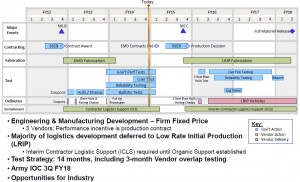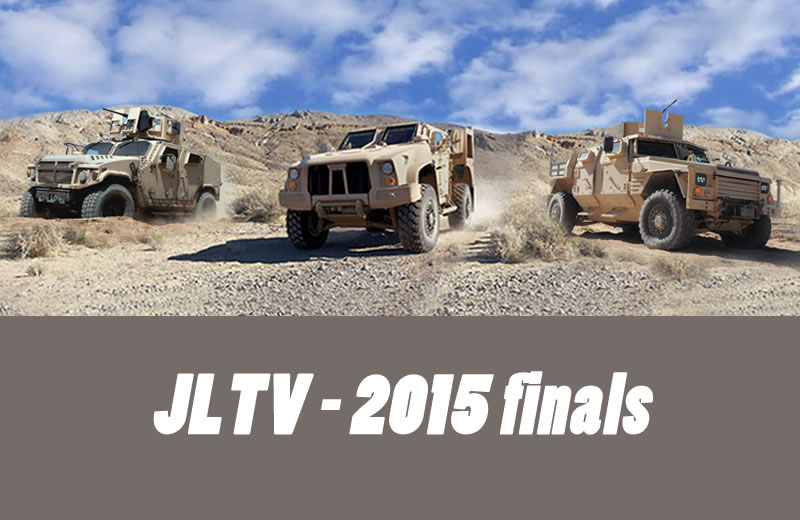[ismember]

[/ismember][nonmember]

[/nonmember] The Joint Tactical Light Vehicle (JLTV) program is moving forward on schedule – on Friday December 12, 2014, the US Army issued a final-version RFP for the procurement of 55,000 armored vehicles to three potential suppliers, clearing the way for AM General, Lockheed Martin, and Oshkosh Defense to submit their final proposals. Source selection is expected in July 2015 with a contract awarded to the winner next year as well.
“The JLTV program remains on track to deliver an affordable, protected-mobility solution that fills today’s critical capability gap with substantial advances in the balance of payload, performance, and protection,” Army Col. John Cavedo, the JLTV project manager, said in a statement. He said the program is on-budget. Both services expect to field their first JLTVs by 2018. Production will total 49,500 JLTVs for the Army and 5,500 for the Marines, with the production cycle ending sometime in the 2030s. Deliveries to the Marine Corps are expected to complete by 2022.
Balancing mobility, protection and payload, JLTV is meant to restore light tactical mobility
Following the Milestone C decision expected within a year, the Army will award a firm-fixed-price contract to a single vendor. The award period will cover three years of low rate initial production and five years of full-rate production, for a total of 17,000 vehicles for the Army and Marine Corps. The kits for those 17,000 will be produced by the selected OEM but follow-on kits might use a different vendor, the Army said. At a target price of US$250,000 per vehicle this phase could be worth over $4 billion.

The new vehicle will fill a gap between the High-Mobility, Multi-purpose Wheeled Vehicles (HMMWV) that serve the Army, the Marine Corps and nations throughout the world as their standard military vehicle since 1984 and the heavy and slow MRAPs that were introduced in some theaters since 2007.
[nonmember]More details are available for members[/nonmember][ismember]The JLTV’s predecessor, the HMMWV, was born during the Cold War, to a bi-polar world, where the ‘forward line of troops’ represented a line of engagement, where the heaviest protected combat forces were deployed. Everything behind this line was considered ‘safe.’ Designed to operate both in safe and combat zones, the HMMWV was introduced with armoured and unarmoured variants, enabling the military to benefit from a single design for multiple missions.
During the past three decades more than 280,000 HMMWVs have been produced – but the world has changed. The four JLTV variants to be introduced in 2018 will be designed with minimal armor and blast protection, but with ample payload reserves to mount additional armor as required by evolving threats. The JLTV is designed to meet proliferated nature of threats in the 21h century. A decade of combat operations in Iraq and Afghanistan, and, to limited a extent in Africa, have exposed the US Army and Marine Corps to threats beyond those the overloaded armored HMMWVs where designed to meet. To meet those threats, the US military opted to invest in the rapid fielding of tens of thousands of Mine Resistant Ambush Protected (MRAP) vehicles – heavily-armoured trucks that provided a high level of protection, but could not maintain the mobility that military operations require. Balancing mobility, protection and payload, JLTV is meant to restore light tactical mobility.
JLTV will initially come in four basic variants: general purpose, heavy gun carrier, close combat weapons carrier and a utility vehicle. The new vehicle is also intended to be affordable – both in procurement and life-cycle cost. But, being heavier and more sophisticated, it is expected to cost more than a HMMWV. In fact, the Army has capped the cost of each JLTV at $250,000 – about four times the cost it paid for an unarmored HMMWV. The life cycle support of those vehicles will also be more costly, as the maintenance of armoured vehicles is different from that of unarmored platforms. For example, transparent, armored windows have a relatively short life expectancy, requiring their replacement every few years. Extending the life cycle of transparent armor would mean the installation of more expensive transparent armor materials, which would increase the vehicle’s baseline cost.
Another important feature of JLTV is modularity. According to Cavedo, commanders operating JLTVs in their units will be able to decide what level of protection their JLTV needs for the mission. Other kits will include command and control and network gear designed to “plug and play” with the vehicle’s open-architecture. Although different vehicles will have different kits, all vehicles come equipped with automatic fire extinguishers, multiple egress options, fuel-tank fire suppression systems and combat locks. All vehicles will be powered by a 300-horsepower fuel-efficient diesel engine.
The RFP is open to the three companies that participated in the engineering and manufacturing development (EMD) – AM General, Lockheed Martin and Oshkosh Defense. All three manufacturers have developed JLTV prototypes that have met the requirements set by the services. Each company delivered 22 vehicles and six trailers for the final test phase, some of which involved operations with Army and Marine soldiers. Those tests also evaluated the vehicle’s reliability over a continuous period of operational use, and survivability, as the vehicles and their armor were evaluated in live firing and blast tests.
As the largest combat vehicle procurement program for the next decade, the JLTV has the potential to reshape the U.S. military-industrial scene – while Lockheed Martin and Oshkosh Defense both benefit from other sources of income, enabling each of these groups to survive the loss, for AM General, a company that relies exclusively on the HMMWV for its income – losing the JLTV would be a final death blow for the company. AM General is betting the company’s future on its “Blast Resistant Vehicle – Off Road” (BRV-O) design, offering the Army and Marines “the best choice to fill the capability gap in light tactical vehicles with respect to innovation, payload, protection and performance all at an affordable price.” While others are describing their vehicles in similar words, it seems that AM General is betting everything on it.[/ismember]




















